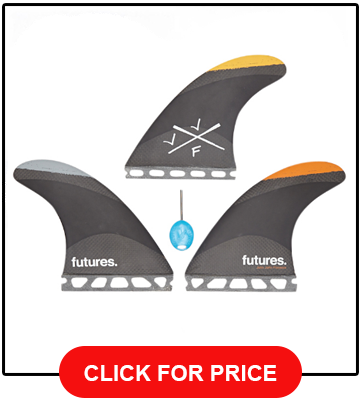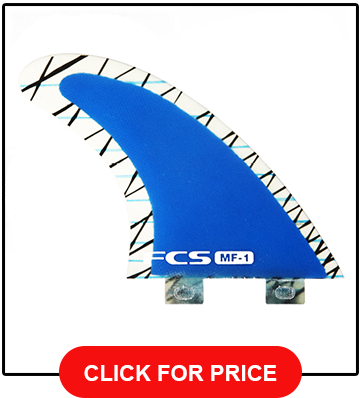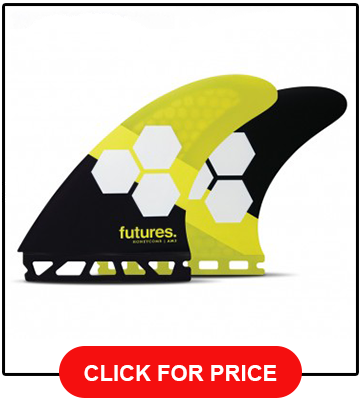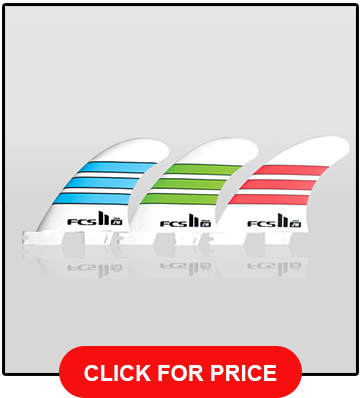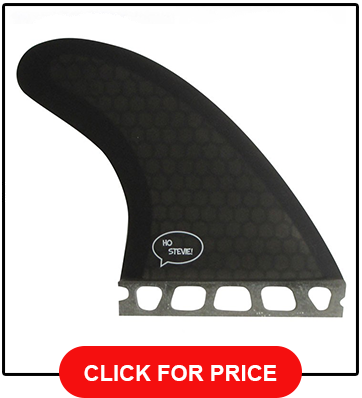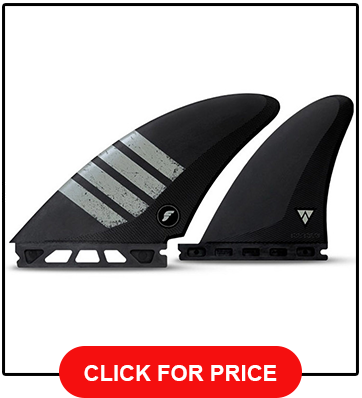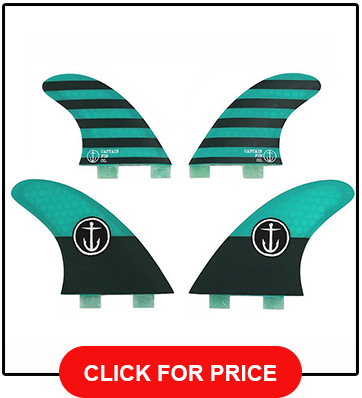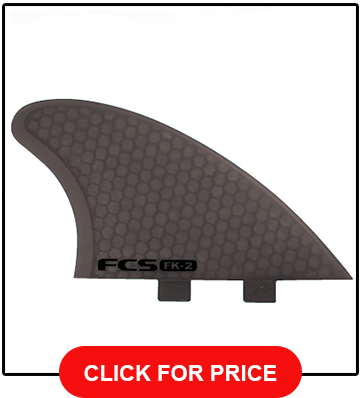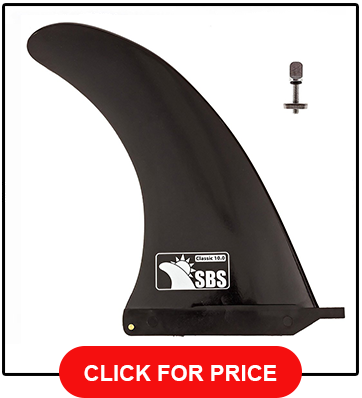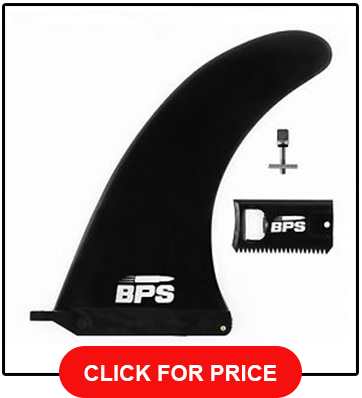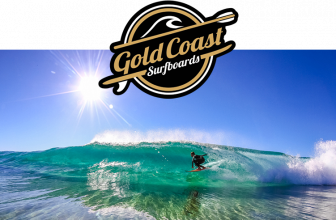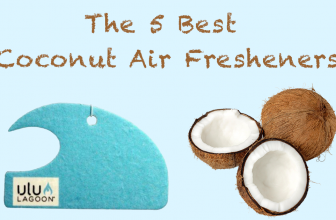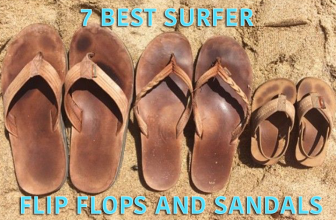
With an incredible array of surfboards on the market that can change the way you surf, most of you might think, “What are the best surfboard fins for me?”...
More...
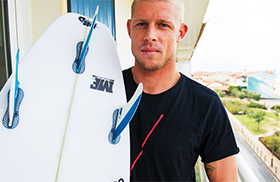
...It’s a question that not many think of when you’re faced with beautiful boards, but it is certainly a question you should ask.
Having different fins can have various effects on the way you surf.
The best surfboard fins on the market are extremely durable and offer an ample amount of stability to ride safely and swiftly.
With so many different fins for so many different purposes, it can be difficult to figure out which one works best for your style of riding.
From flexible fins to removable fins to fins of different shapes and sizes, we’ve created a list to help you choose the surfboard fin that fits you best!
The 11 Best Surfboard Fins
Thruster Surfboard Fins (3 Fins)
#1 Choice - Futures John John Techflex
5 Star Editorial Review!
Our favorite on the list, the John John Techflex fin has a reduced and refined tip combined with a medium base that delivers very reliable drive, release, and control in the most commanding surf.
The lightweight, medium flex pattern design offers incredible feel and authority for professional surfers around the world.
The thruster set is available in small, medium, and large sizes with an upright template that even feels a bit looser, making it great for kids!
The 8-12 face works incredibly in big waves, but can also get the job done in smaller waves as well. The flat-foil designs on these fins help you to break free sooner and can also help in controlling your speed.
This is why they are so great for big, powerful surf because you don’t need to create any more speed.
The TechFlex construction similar to fiberglass in that it is very stiff, though much lighter than honeycomb.
With an array of high-performance features that offer some serious power and control, the John John Techflex fin should definitely be any surfer’s weapon of choice through all conditions.
FCS MF1 Mick Fanning
The FCS MF1 Mick Fanning fin comes in medium and large sizes and both perform excellently for surfers that love long carves with maximum power and flow.
Great for kids, adults, and professionals alike, the elongated tip will help any surfer to respond quickly in high speeds.
Not only can speed be controlled with that tip, but also the side fins have a bevel on the leading edge that helps you to move from rail to rail at crazy speeds.
The ultra stiff flex pattern sprouts up from the base all the way to the tip so that you can maintain drive through sharp turns.
To help you cut through the water without noticeable drag, FCS developed a cross section foil that is super thin.
Most experienced surfers agree that the FCS MF1 has a commanding combination of performance and speed.
Wrap all of that up with an incredibly versatile construction that feels very similar to a lighter fiberglass, these fins are truly great for all different surfing conditions.
These fins are made to give you the same feel and style of Mick Manning, so you can rest assured knowing that they are very legit.
Futures Jordy Smith
This South African powerhouse of surf, with his young, progressive, and highly aesthetic style, has created the Jordy Smith Futures that was designed for speed, power, and versatility.
Jordy’s signature template helps a surfer to maximize speed and force when they are going around sharp turns.
This makes sense because Jordy Smith is known for his ability to forcefully drive at the bottom of turns.
The wide base and narrow tip help to generate speed instantly.
As for the overall performance, the most impressive part is the flat foil design to help control that wild speed in the bigger waves.
Cut from a honeycomb material that is incredibly lightweight, the fins have a durable, medium flex pattern that works up to the narrow tip.
Mainly pro level surfers, to turn under crazy force, use this type of construction. These fins come in a large size and are best for those with larger builds.
FCS Julian Wilson
There are a couple different versions of the FCS Julian Wilson fins, but these are the original ones with Wilson’s signature touch.
With a 4.40” base and a pronounced point on the tip of the fin designed with a focus on speed, it is an excellent choice for those trying to mimic the lip riding style that Wilson is known for.
The Performance Glass construction is cut from panels of layered fiberglass that offer stiffness, as well as a ton of tip response that give you the same feel as a traditional fin.
The sharp leading edge, as well as the low sweep value across all of the fins, allow a surfer to turn in an extremely tight radius.
The stiff base creates the whipping sensation on those turns with a subtle tip flex.
Overall, this fin was designed for solid beach breaks so you can hit the water like Wilson.
Ho Stevie! Perfect Flex w/ Honeycomb
Ho Stevie! wanted to design a fin that would be excellent for driving down the line, hitting solid beach breaks, or launching into aerials like the pros.
The G5 medium template is similar to the Jordy Honeycomb in many ways. The main differences are that these fins have a relatively low sweep value at 33° with a less pronounced tip.
These fins are honestly great for all-around performance.
They offer a loose enough design to allow you to turn and move, but stiff enough so that you can still drive into barrels.
The Honeycomb Fiberglass design also adds to the performance of the board as it provides the perfect amount of flex.
Essentially, if you’re looking for some quality fins that can match up against pro fins at an incredible price, these fins are the ones for you!
Quad Surfboard Fins (4 Fins)
#1 Choice - Futures Unisex Controller Alpha (B072M7RF5N)
5 Star Editorial Review!
Get rid of your plastic quads and grab a set of the Alpha Series quads!
Though most people believe that thruster sets are better for surfing, these quads actually deliver high performance.
The special composite design on these bad boys, with the help of 3M, helps to maintain a great balance of spring, hold, and predictability.
These fins work great for a local beach break or high performance lines so it is truly up to you what you use them for!
They ultimately give you greater control than a thruster configuration.
Even with the maximum control, these are great for creating a sort of drive in smaller conditions because of the bigger surface area, fiberglass design, and the V2 foil.
They are even lightweight enough because of the carbon infused air so you don’t feel the drag!
Futures designs some super high quality fins that will last you a very long time, so no need to worry about the possibility of a snap.
Ho Stevie! Perfect Flex w/ Honeycomb
The Ho Stevie! Perfect Flex w/ Honeycomb Quad is a set of quads made for maximum performance!
The Inner rear fins GL Template allows the Ho Stevie! quad to generate speed, power, and flow, while also having more balance than the thruster set.
The Perfect Flex’s honeycomb fiberglass provides an excellent amount of flex so you can drive down a fast breaking line, rip through wild turns, or launch into aerials, all while providing an ample amount of flex.
Whether you’re surfing at your local beach break or pumping down powerful lines, you will get excellent performance! The Ho Stevie! Perfect Flex fins are made with a honeycomb fiberglass design hence the name.
They are super lightweight and can fit on to any long board, short board, or fun board.
The best part about purchasing a Ho Stevie! product is that, if the fin breaks within a year, they will replace it for absolutely nothing!
Captain Fin Co. Quad Fins
The Captain Fin Co. Quad Fins are a member of the Captain Fin series, which makes fins for all kinds of boards and surfing styles.
The Captain Fin Co. Quad Fins, however, are designed for a very specific feel.
These fins are a twin tab set that offers a surprising amount of flex for a medium flex set.
Perfect for all surfers, though best for larger surfers because of the 80/20 foil, and they also offer an incredible amount of pivot and hold.
If your board is set up for a quad set, these fins will offer you reliable performance in all types of conditions!
The Honeycomb RTM is designed to offer that flexible feel as well. The longer rake provides a solid flick for those times when you need a bit more speed and push.
If you only have the ability to buy one set of quad fins, we definitely recommend these!
Twin Fin (2 fins)
FCS FK-2 Performance Core
These are the one pair of twin fins that we decided to stick on our list and they are amazing for high performance surf!
The medium sized fish keel with less area make this template very unique.
The tested 70/30 foil makes paddling super easy and is great for surfers who are smaller because of the high maneuverability. With the base, depth, and rake put together, these are actually pretty small fins.
They do, however, work with any board that is set up for 2 tab fins.
Like the other FCS fins on our list, these are made with the same Performance Core material that offers the feel of a traditional fiberglass.
The great part is that these aren’t nearly as heavy as your traditional fiberglass fins!
Longboard Single Fin (1 fin)
SBS 10" Fin
If you have a longboard or stand-up paddleboard, you’ll definitely want to pick up one of these classic SBS 10” Fins.
Constructed with a glass-filled nylon, the fin is meant to be stiffer than fiberglass, though a lower-grade material closer to a plastic fin.
These fins work on just about any SUP, surfboard, or longboard with an 8.5” or 10.5” fin box so they are pretty universal.
Like most popular single fin products, they come with a free “no tool” fin screw so you can pop in and install your fin without any extra hassle or tools.
The classic foil on this bad boy makes for excellent hold in all kinds of conditions, whether you’re paddling on flat waters, turning fast into big lines, or riding the nose.
BPS US Box Center Fin 8, 9 or 10 inch
The BPS US Box Center Fin is an excellent single fin for all SUPs and longboards that have US Style or Universal fin boxes. In 8in, 9in, and 10in sizes, each fin is an exploration into a new feel for you.
The foil template makes it super easy to paddle and track with so your board stays straight as an arrow. Made with fiberglass-reinforced nylon composite materials, this fin is ultra strong and flexes very similarly to the SBS 10” fin.
It even comes with a free “no-tool” fin screw, a plate, and a wax comb that’s combined with a bottle opener and a hex key.
It’s pretty cool of BPS to throw in some extra little goodies along with their fin at a great price.
Also be aware that they have the same 12-month warranty as the fins from Ho Stevie!
How To Choose Surfboard Fins
Removable vs Glassed-On
For years and years, glassed-on fins were the only types of fins that you could find on a surfboard. Removable fins are a fairly new concept in the history of surfing, as they only started to come about in the early 1990s. Nowadays, you’ll mostly see removable fins across the board for pros and amateurs alike. As more and more surfers have the desire to try new fins so they can harness new feels on their boards, more and more surfboard manufacturers have stopped glassing their fins on. There are definitely pros and cons of each style that are nice to know before making your decision.
Because glassed-on fins are attached to the board, they’re typically much lighter than having the extra weight of removable fins. Because they are solidified to the board, many surfers will often note that they feel less drag, as well as having smoother rides overall. Lastly, the glassed-on fins have naturally sturdier bases, which allow for some great flex in the tip. Combine those two things and you have excellent flex response on these glassed-on fins. One of the major issues with glassed-on fins is that they are not the most ideal for traveling, especially if you’re rolling in a van with multiple boards stacked up on each other. The other major issue with the glassed-on fins is that, if they snap and break, you’ll have to get your entire board repaired rather than just picking up another set of fins. That can be very costly and time-consuming.
Removable fin systems are awesome because they allow you try a wide variety of fins on your board. Having the freedom to experiment is awesome. You can truly have 10 different boards in one by switching thrusters for quads or fiberglass for honeycomb. They allow for more ease in the long travel unlike the glassed-on fins. It’s also much easier to fix when one of your fin breaks, unless it completely takes out the fin box, which in that case can be as detrimental as a glassed-on break. The major con is that if you are constantly switching fins in and out, it can be a bit harder to completely dial-in your set. They are also typically heavier than glassed-on fins, and because of the weight and looser attachment, tend to have a bit more drag.
Fin Systems - FCS Dual Tab vs Futures Single Tab
In a perfect world, all longboard fins would be completely compatible across all fin boxes. Although it is generally pretty easy to swap out fins without worrying about compatibility, some fin boxes fall under very specific categories.
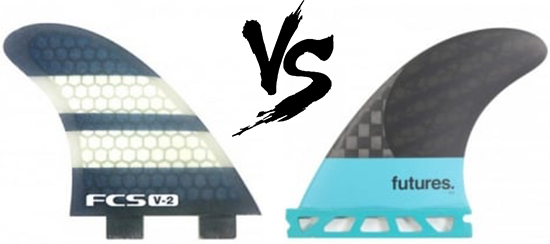
Fin Control System, better known as FCS, is one of the world’s leading fin system manufacturers. One of their fin box designs is the dual tab design. Essentially, the fins are attached to the board using two tabs or plugs that are held together with screws. The good thing is that these are super compatible with other FCS fins and easily the most popular, so you’ll find all over the world. That makes them super easy to replace these at any time. The main issue with these dual tabs is that they’re designed to break in high stress situations.
With the single tab Futures, they are unfortunately not as popular, but just as sound. They work with a truss base that runs along the entire bottom of the fin so you can just slide them with screws. They typically fit a bit more snugly than the dual tab fins and make for an incredibly strong, yet lightweight connection.
Fin Size Chart
The main thing you’ll want to look at when deciding on the size of you fin is how much you weigh. The chart below can help give you a general sense of what you should be aiming for, though is not totally gospel. Your fin size can also depend on the size of your board or the types of waves that you’ll be riding.
If you’re around 165 pounds and you have a smaller board, you might want to try and get the medium size. Conversely, if you’re that same weight though riding on an 8-footer, the large fin might be best for you. Check out the chart below for more info in detail!
SIZE | WEIGHT (LBS) |
|---|---|
Grom | <100 |
XS | <120 |
S | 105-155 |
M | 145-195 |
L | 165+ |
XL | 190+ |
Fin Type
When you finally figure out what fin size works best for you, you’ll want to figure out what fin type is compatible with your board. You’ll figure that out by taking a look at the underside of your surfboard near the tail. You’ll see a few slits, or fin boxes, in the board, anywhere from one to five, which will tell you how many fins you can fit on your board. Typically you’ll find singles, twins, thruster or quads, though many manufacturers have started making their board with five boxes so surfers can easily get creative with their fin configuration.
Single Fin
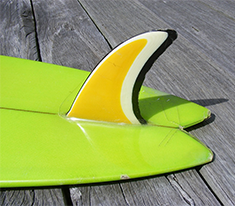
More commonly than anything else, you’ll find a single fin on longboards. This is because they are the most traditional in style, and what better to pay respect to the ancient gods of surf than with the single fin that started it all? They definitely compliment the original style of longboard surfing as well, as they work best for shooting straight down the line without too many turns.
Unfortunately, trying to turn sharply with a single fin is not an easy maneuver. What they lack in turning, however, they do provide in control, stability, and predictability. Most longboard single fin boxes allow you to adjust your fin closer to the front or the back so you have control in how loose the feel is.
Double Fin
If you want your board to have more of a playful and amusing sort of feel, with ease in turning and maneuverability, that is almost completely the opposite of a single fin, the double fin is right for you!
You’ll like these the best if you’re out riding smaller waves rather than the crazy rogue waves, as they’re mostly designed to give you extra speed that is unnecessary in the big game. If you’re a skater, these types of fins will definitely give you the closest feel to shredding on land as well.
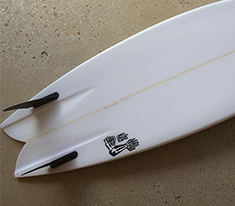
Thruster / Tri Fin
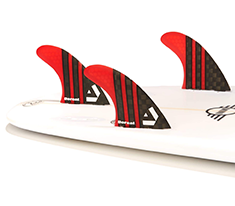
The Thruster set is easily one of the most popular fins in modern day surfing and is perfect for a wide array of surboards, no matter what shape or size. The fins are set up in a triangle with two fins up closer near the center and the rails of the board angled inwards, and a single fin closer to the tail right in the center.
The outside fins help to cut through the water better so the rider can increase their speed. The single, which is completely symmetric on both sides unlike the flat and rounded outside fins, offers the rider better stability.
Excellent for pros and beginners alike because of the ample speed, control, and maneuverability that is more well-rounded than any other type of set, we definitely recommend picking up a thruster no matter what kind of surfer you are! If you want to change it up in the future, it’s very easy to make it a single or double!
Quad
Quad fins use the science of slicing through and channeling water to the tail end of the board so that you can accelerate easier and faster.
It kind of works like a thruster set as the outer fins add speed while the inner fins add stability.
With even more stability than thruster sets, these are an excellent choice for the big wave surfers out there.
When you’re driving down smaller lines, they also give you control and speed when turning.
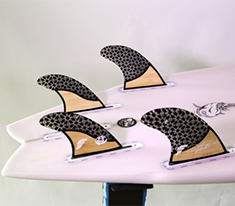
5-Fin

Even though you have five fin boxes on these boards, you definitely don’t want to have all five fins on your board at once. Manufacturers only make them this way so that you have the option to configure your board however you’d like.
It’s great knowing that you can totally change up your board depending on how the surf is looking that day, or how you’re feeling. It’s also cool because the one board you have doesn’t have to be a one-trick-pony.
2+1 Fin
This is a fairly new configuration in the world of surfing that is increasingly becoming popular. It essentially works the same way as a thruster fin, though the center fin box is longer so you can set a large longboard fin in it.
The cool thing about this is you can set your fin closer to the center or tail to have the same control over your feel that you have with a single fin setup.
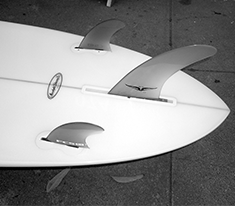
Your Situation
Your Board
Obviously the first thing you’ll want to look at when selecting your fins is how many fin boxes on your board. Though more fin boxes can give you more options, having less can sometimes be easier so that you can narrow your focus.
There are also some little things to think about, such as, you probably won’t want to ride a 6-footer with a massive single fin. That just doesn’t make sense.
The Waves
Something many people don’t think about before buying a set of fins are the kinds of waves that they’ll be surfing the most. Fins that have a leading edge that curves a lot less soon, or are less angled, are much better for turning into tighter spaces and barrels.
If you’re surfing your local beach break where the waves don’t have a ton of surface area, or they are breaking much faster than your standard waves, that sharper leading edge will be much better. Conversely, if you have a fin that has a more prominent rake, it’ll be easier to get into longer and faster turns where a sharp leading edge would feel a bit shakier.
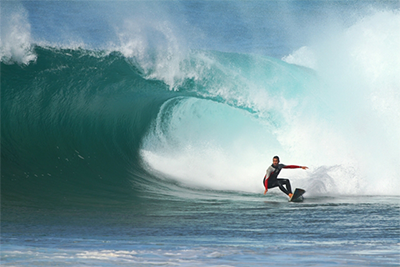
Your Surfing Style

This is another variable in choosing your fin that requires a bit of self-awareness. If you’re a very aggressive surfer who is constantly driving fast and pushing hard down sharp turns, you’ll probably want a fin with heavy-duty carbon or fiberglass, as it will be a hell of a lot more sturdy.
If you’re a lighter surfer who just likes to flow down lines that are a bit more relaxing, a super stiff fin might kill your groove.
Having a fin that flexes allows you build speed down turns with less push on your part as you are getting the extra spring from the flex to jolt you forward.
If your fin feels to soft and doesn’t have that pop or spring from the flex, you’ll get a washier and more relaxed feel on your ride.
In that, we can definitely say that surfers who are more aggressive should get fins that are a bit stiffer than others and surfers who are more laid-back should get fins that flex more.
Fin Specifications
Sweep / Rake
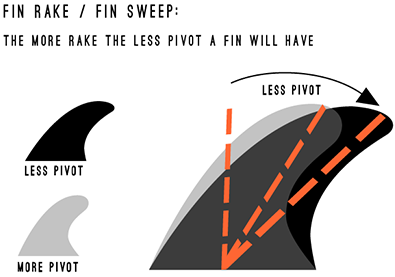
The sweep, sometimes known as the rake, is the amount of arc your leading edge has. The sweep is usually measured in degrees, a measurement that is relative to the flat base. If you’re a surfer looking for extra speed, control, and stability, a fin with a smaller rake is your best option.
On the contrary, fins with shorter rakes aren’t the most ideal for turning in a small radius. If you’re a surfer looking for that more playful feel, a fin with a longer rake is better for you. Though they aren’t as stable, they’ll definitely help you to turn fast.
Toe / Splay
The toe or splay of your fins are measured by their angle in relativity to the centerline of your board. People will typically mention fins and say that they are “toed-in.”
This just means that they are angled to the center of the board with the outside of the angle towards the tail. The reasons fins are set up this way is so that water can push against the outside of the fins to create pressure, while the insides of the fins can cut and channel water to the tail of the board. This creates balance, stability, and speed.
Base / Length
The base / length of the fin is the bottom of the fin which is at a 180° angle and is the longest portion of the fin. It sits inside of the board when it is fully connected. The length of the fin has a surprising amount of effect on how your board will respond to you.
When your base is long, it creates more area for water to run past, in turn creating more speed. With a shorter base area, it is much easer to make much sharper turns, as you’re not pushing a larger portion of fin through the water.
Foil
Fins are two-sided, and each face is not always symmetrical. If a fin says it has a foil measurement of 70/30, this means that one side is more concave than the other. On the other hand, some foils can be completely flat.
A different foil will alter the way water runs across the fin, changing the way your board will ride. A fin on the middle of your board, like a single longboard fin, is typically flat, or 5050, adding stability to your board. The outside fins, such as on a pair of thrusters, are typically concave on the inside.
If the inside of a fin is flat-faced, you’ll typically find that it balances better, creates a bit more speed, and allows for you to move playfully on your board. If a fin has concave angle on the inside will lift your board better, as well as help to minimize any drag.
Height / Depth
The height on a fin, which many people will refer to as the depth, is the measurement from the base of the fin to the highest point on the fin, or the tip.
Different heights can change the stability of your surfing. If you’re a surfer who is looking to gain better control, especially on turns, a taller fin will be your best choice as it makes doesn’t require as much focus and tension and it would with a smaller fin.
Shorter fins are far less stable; though definitely make it easier to hit waves with a flow-y sort of feel. If you’re a surfer who is trying to perform tricks or spins, most definitely check out some shorter fin sets.
Cant
The cant is how much the fin angles from the bottom end of your surfboard and is measured in degrees. If a fin is completely straight at a 90° angle, you’ll get more speed. If the angle is any smaller than that, you’ll typically get a bit more responsiveness.
This responsiveness is essentially control, and control can be very helpful if you’re trying to go through sharp turns or riding in unpredictable waters. If you’re looking for a lot more drive and you’re okay with your board being more unpredictable, you’ll definitely benefit from a 90° angle. If you want that playful sort of feel from your fin that makes it a bit easier to maneuver, you’ll benefit a ton more from a fin that is canted.
Area
The area of a board is typically measured in square millimeters and that measurement is referring to one face of the fin. Usually it goes: the bigger the surfer, the bigger the fin. If you’re a big guy or girl, you’ll most likely need that extra control.
A smaller fin typically makes the ride feel a bit looser which works well for small surfers. This is probably the most fluid variable in fin measurement, as it totally depends on the preference and personal feel of the surfer. We definitely recommend trying out different sizes while keeping in mind the ride feel.
Materials
Fiberglass
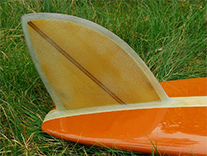
Fiberglass is definitely the most traditional style of surf fin out there. Essentially, manufacturers layer up multiple layers of fiberglass that are held together with a strong resin and then cut into the shape of the fin.
These fins are very strong, and though mostly very stiff, have been made to be a bit more flexible with modern design.
If you’re surfing any regular surfboard or longboard, a fiberglass fin will do you just fine. If you’re riding a shortboard, these types of fins are absolutely perfect!
This is because they are extremely lightweight and they do not flex that much, giving you more control and stability.
One of the main issues with fully fiberglass fins is that they need to be made by hand. This is why we see composite fins more than anything these days.
Composite Fins
Composite fins are exactly what the name states. They are a composite of different materials. If you pick up surfboard from a shop that already comes with a fin attached, you are most likely receiving a composite fin.
Composite fins are so popular because they can be made quickly and easy, factory style, with resin transfer molding. Essentially, fiberglass that is mixed in with a resin is injected into a fin-shaped mold. That fin hardens into a plastic-like material that is fairly lightweight and still very strong.
The issue with these is that they typically don’t have the proper flex that is necessary for a great fin, resulting in a washy and loose sort of feel that is far from ideal.
G10 Material
If you’re looking into another cheap alternative to pro fins, that G10 material fins are a type of composite that works a little better than standard composite fins. Many large fin manufacturers are starting to make these fins, as they’re fairly easy to mass-produce with a mix of epoxy and fiberglass in a fin mold.
They’re definitely a lot more durable and flexible than your standard composite fin as well. Manufacturers also wanted to take away the washy feel of standard composite fins, so they made these to have more flex. This results in better pop, drive, control, and stability.
Performance Core Fins
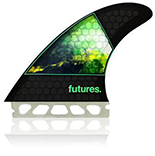
For a long time, people were just molding the fins into a material that was the same throughout.
As time went on, manufacturers realized that they could instead fill the cores of their fins with different high-grade materials than the outsides of the fins to give them different characteristics.
You may remember a lot of the honeycomb fins from our list of fins.
These fins are injected with a carbon, Kevlar, or something of the like that is strong and lightweight, and molded in a honeycomb shape to add a distinctive flex property throughout the fin without making it too heavy.
This mold is made, and then using resin transfer molding, a fiberglass outer core is wrapped around it. In our opinion, this is the ultimate modern day fin that combines the best characteristics for the ultimate surf experience.
PC Materials and Fin Flex
You would think that fin manufacturers would stop exploring after creating such an incredibly well rounded fin such as the honeycomb. That is not the case at all. Manufacturers have begun combining materials such as Carbon, Kevlar, Texalium, and more, into different mixtures and combinations with various ratios. When you begin to mess with different ratios of these components, you start to see different flex patterns.
Every single combination of these components offers it’s own unique flex, release, drive, etc. when riding. The possibilities are pretty much endless. You will most likely see pro surfers riding these types of fins as they are very high-end and take close attention to detail. The beauty is that you can truly make the fin that is perfect for you if you so choose to.
How To Install Surfboard Fins
Installing your surfboard fins should really only take a couple of minutes and is a fairly easy process.
Even with that said, we’ve made a little guide with a step-by-step explanation for those of you who have never installed fins before and want to make sure you are doing it right the first time around.
Set Back The Screws
First thing that you’ll want to do is loosen the screws that are set up inside the fin box.
You don’t need to take them out all the way, they just need to be loose enough so they are not blocking the bed of the fin box, allowing you to slide your fin in.
Orienting Your Fins
If you have multiple fins in your set, you’ll need to figure out which fins go into which boxes. For thruster fins, all the fins will be the same size, though the center fin will be rounded on both edges.
If you’re working with a quad set, the larger side fins will go closer to the center of your board while the smaller fins will be set close to the tail.
If you have a 2 + 1 set, the center fin will be the largest fin and will be typically be made of fiberglass while the smaller fins will be set towards the sides.
Installing Your Fins
Different types of fins will work a bit differently in terms of installation, though they are all just as simple as the next.
FCS
For FCS fins, you’ll see that they have two heads.
These two heads or plugs will be inserted into the two slots on your board.
When you begin screwing them in, do it very gently as over tightening can result in a broken plug.
Futures
If you’re setting up Futures, you’ll be able to tell because they have one long slot rather than two slots like the FCS fins. That one slot will line up with the one plug on your fin. You’ll want to loosen your screw and line up the slot with the small nub in the back of the fin box, push it in securely, and then snap the front end down so it’s snug inside the box. Makes sure the fin is flushed before tightening your screw.
With a longboard fin or single fin, each fin will typically come with a screw or nut. First start by taking the nut off and placing it in the center of the fin box and slide it in until it is flat at the bottom of the fin box. When it’s down in there, you can choose how far back or forward you want to put it. Remember earlier we talked about the further forward your fin, the looser your board will feel. Put the front of the fin into the box until it hinges and line up the hole in the back of the fin with the nut. Screw it in and your set.
Always make sure to give your fins a little wiggle before actually getting out in the water to make sure that they are completely secure. Nothing worse than a lost fin!
Frequently Asked Questions
Are There Ways To Measure Flex in Single Fins?
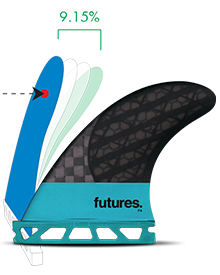
Yes! When checking out longboard fins, we can usually break them down into four different categories: Flex Fins, Rake Fins, Pivot Fins, and D Fins.
Flex Fins, like the name says, have the most flex out of all of the fins mentioned and work great with almost any board. They always have a much wider base than most fins that taper into a narrow tip. These are great fins to propel you when you’re coming out of turns
The Rake Fins, which have a bit less flex than Flex Fins, still have a pretty wide base, though a much wider tip than Flex Fins. This way you can get some flex while also having a little more control and maneuverability.
Pivot Fins are pretty much the standard for nose riders. If you find a fin with a wide base and a vertical outline, that would be a Pivot Fin. They’re made to keep your cool in the water and hold the tail of your board deeper in the waves so you can walk out to the front and still maintain control and balance.
They’re a little harder to turn in a tight radius than Rake or Flex Fins, though definitely possible.
Lastly, D Fins are probably the least versatile when it comes to surfing. They’re called D Fins because they somewhat resemble the letter “D”. They can be found with either vertical or curved forward edges and are typically for traditional riders who are riding bigger logs. They’re much harder to turn and ride the nose on, though great for those looking to shoot straight down the line.
If I’m looking to get more speed on my board, what should I do?
So to simplify all of the information we’ve just thrown at you, if you want more speed, we definitely recommend switching out your thrusters for quads. Thrusters are awesome in many ways, though naturally the back fin will cause a bit of drag. If you want to completely get rid of that drag, you’ll have to get rid of the fin. Quads keep that backspace open allowing the water to channel through better than any other set.
Secondly, make sure to always clean the underside of your board. Sometimes your fins aren’t the problem, and the problem is all the dirt, sand, wax, and grime that build up on your board. Do yourself a favor and clean it after every ride. You can either sweep it with a comb, credit card, or pick up some cleaner from your local shop.
Besides Longboards, what kinds of boards will benefit from larger fins?
If your surfboard has a wider tail, you’ll definitely want to get a larger fin to match it. If you’re a shortboard rider but you are constantly riding big waves, you’ll most likely want to get some larger fins as well.
Can I surf without any fins?
Ancient Polynesians, Hawaiians, and Tahitians, the ancestors or surf, did not have fins on their boards. The thing is, they were mostly riding their boards directly into shore and the only way to turn them was by sticking their foot in the water. So yea, you can definitely surf without fins, though it’s pretty dangerous not being able to turn or maneuver in the water. We definitely do not recommend trying it unless you are expert level.
Are Different Fins Better For Different Skill Levels?
If you’re in the advanced category, or are a pro surfer, you’ll benefit the most from Performance Core fins, as they are very responsive and stiff, allowing you to push through turns.
If you’re intermediate, the Performance Core fins will also give you a consistent feel in a wide variety of conditions.
If Performance Core fins are too expensive for you as an intermediate or novice surfer, we highly recommend looking at Neo Glass fins. These are heavily fiberglass-induced fins that don’t sacrifice performance capabilities for the cost.
If you’re a new surfer, Glass Flex fins will give you what you need to stay comfortable and stable on your board while you progress.
Final Thoughts
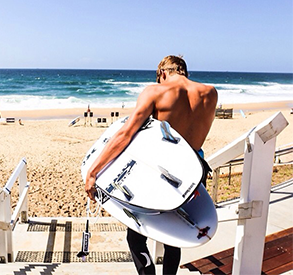
The options when choosing fins, as when you are choosing your surfboard, are virtually limitless.
This is awesome because there is so much room for experimentation.
Though it may seem like we touched on just about everything in the world of fins, there are many other hybrid or boutique-style fins out in the world that can offer different combinations of flex, strength, and performance.
If take those ideas and combine them with the unlimited variety of shapes, foils, templates, etc. the possibilities for the future of surfboard fins are astronomical.
If you ever begin to feel complacent with your surfboard fins, try something new! Who knows, it may completely change your outlook on surfing!

